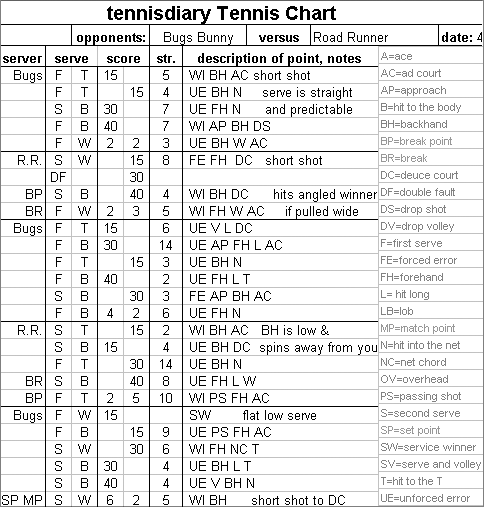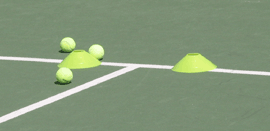I recently received a copy of In Tenn Video Tennis Magazine. Here are my thoughts.
It comes on a DVD and there’s a lot of stuff in there: drills, lessons, body mechanics, nutrition, interviews with players and organizers, celebrity events. It’s like Tennis Magazine on steroids. (Maybe I should find a different expression in today’s sport’s climate.)
Let’s start with the advertising. If I’m listening to the radio, I just go to another channel when I hear a commercial. If there are commercials on all of the AM sports radio shows, not an uncommon occurrence, I go to my FM channels. When those annoying subscription cards fall out of the magazine I throw them away. If they stick in the magazine and make it hard to turn the page, I rip them out. When I come across those pages of glossy ads that seem to go on longer than the magazine itself, I flip through them as quickly as possible.
On this DVD there are 15 second subscription teasers and 30 second commercials at the beginning and end of many features. You can’t TiVo past them but, luckily, you can fast forward.
There aren’t a lot of DVD magazines out there but tennis is a good subject for video. You see the drills played out. You see how computer software can analyze your tennis stroke. There is a good example of this here. There is good instruction in using proper body mechanics which is important. Most recreational tennis players I know have injury issues. I particularly like Corky Cramer’s lesson on using your entire body to hit a tennis ball. Swinging at a tennis ball with your arm only instead of engaging your feet, legs, butt and core muscles is a prime contributor to tennis elbow and other arm injuries.
One piece features an interview with yet another family pooling their resources to get their children to the top of the professional tennis world. Tom Stafford is a multimillionaire African American. He and his wife Michelle, their children Jabari, 9 years old, and Emira, 7 years old, the tennis instructor, the trainer and their agent make up Team Jamira. If their children decide not to play tennis that’s o.k. with their parents but whatever the children choose to do, Tom Stafford says, “We’re gonna make sure we get them to the top.”
Editing video footage is its own kind of editorializing, you can’t edit without a point of view. But the editorializing is stonger in print media because the writer chooses the words to present the subject. In a video magazine, people speak for themselves.
This feature for instance is begging for commentary. Stafford is taking his multimillionare business model and applying it to his kids and that’s pretty scary. I mean, this is a guy who said the following in a Sport Illustrated article: “I know for a fact that if my kids keep going, they’ll be the Number 1 players in the world one day. My daughter’s gonna kill these bitches. She’s gonna be on the tour by 11. I guarantee it. Mr. Williams ain’t the only crazy motherf—– out here.” Since very few sentences in the article passed without Stafford swearing, I don’t know how In Tenn managed to get a G rated performance out of him.
Put Brad Gilbert and John McEnroe in a studio on ESPN and let them go at it. They’d be happy to pick players apart, blast tennis officials and each other.
What’s missing is editorial voice. This is a problem with tennis media in general. How often do you read a controversial article in a tennis magazine? And here, except for editing, there is no voice. We don’t even see the interviewer.
Not that they don’t criticize tennis. Mac McIngvale, chairman of the Tennis Masters Cup in Houston, talks about the poor job organizers do in marketing tennis events. I can attest to that. Each year when I tell people that I’m going to the WTA Tour Finals at Staples Center, everyone is surprised to hear that a tennis event is in town.
McEnroe is talked into expressing his well known views about the Davis Cup schedule and the lack of personalities today. Tennis was more popular when you could see McEnroe and Jimmy Connors acting outrageously on a regular basis. The Williams sisters have been propping up tennis for a while. It’s time for something new.
Put Brad Gilbert and John McEnroe in a studio on ESPN and let them go at it. They’d be happy to pick players apart, blast tennis officials and each other. I listen to this kind of thing on sports radio all day. It’s called passion. Tennis fans are as passionate as any other sports fan. Check out this thread at tenniswarehouse.com. It goes on for six pages and gets a bit nasty in places.
At $22.95 for four quartery issues, In Tenn costs about twice as much as my monthly Tennis Magazine subscription. It’s definitely worth it.
Meanwhile, let’s see how we can get more passion and editorial coverage of controversial issues into tennis media.


 Since I abruptly said goodbye to my longtime hitting partners and therefore don’t have anyone to hit with anymore, I hit against the backboard today. The wind was gusting and I was getting frustrated because it was pushing the ball into my body very strongly and I couldn’t hit a backhand. To deal with my frustration I decided to find a target on the wall and hit every backhand to that target. Since the target was pretty high, I had to hit up on the ball. After a little while I had developed a pretty good topspin backhand.
Since I abruptly said goodbye to my longtime hitting partners and therefore don’t have anyone to hit with anymore, I hit against the backboard today. The wind was gusting and I was getting frustrated because it was pushing the ball into my body very strongly and I couldn’t hit a backhand. To deal with my frustration I decided to find a target on the wall and hit every backhand to that target. Since the target was pretty high, I had to hit up on the ball. After a little while I had developed a pretty good topspin backhand.